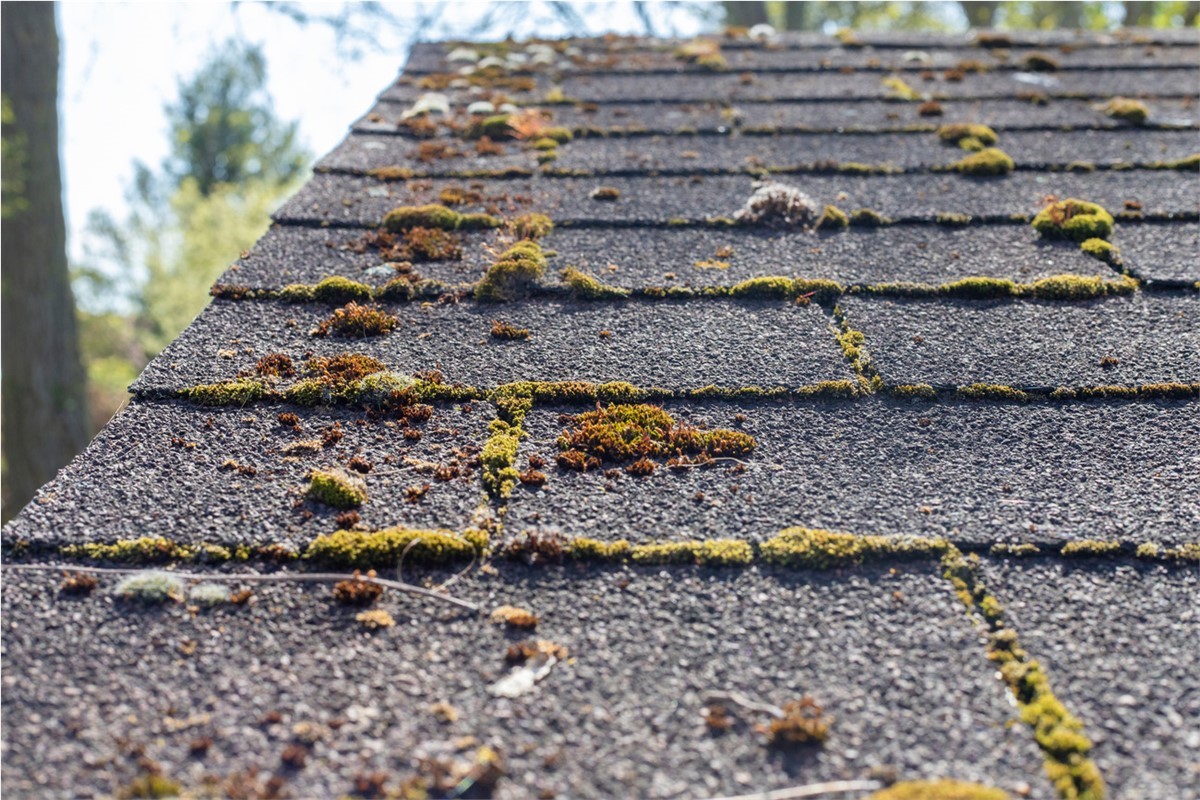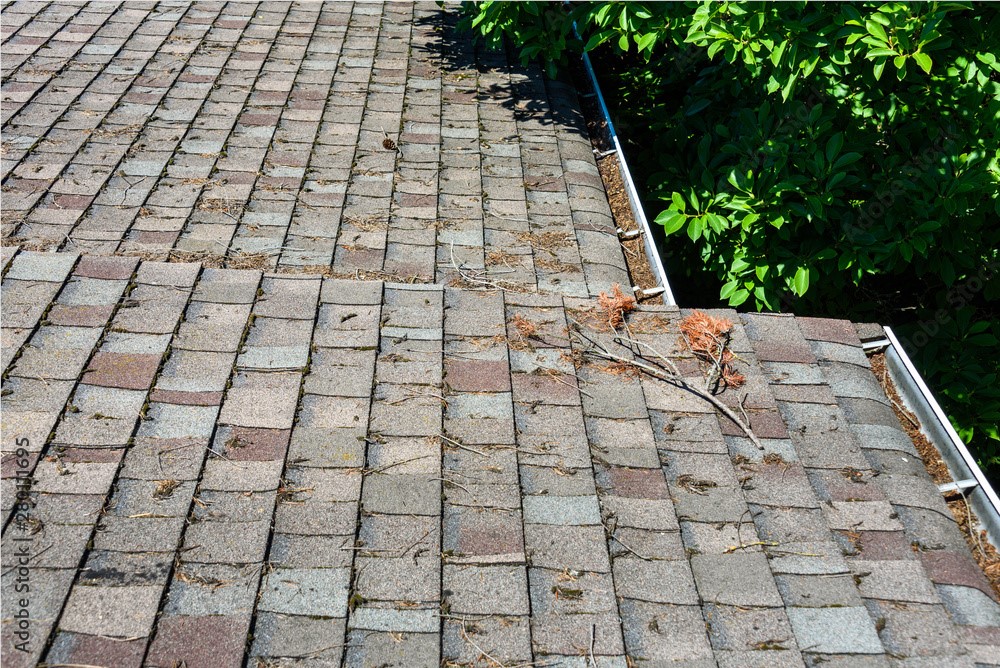
You’ve probably seen roof algae before and just don’t know it. If you’ve ever seen black streaks running down asphalt shingles, you’re looking at dried roof algae. It is not a sign of melting shingles or an improperly installed roof. Quick facts about roof algae.
- Yes, it looks unsightly.
- No, it will not go away on its own.
- Yes, it will continue to worsen year after year.
- No, you don’t need a new roof.
- Yes, you should clean it yourself or invest in professional cleaning of your roof to limit its spread.
- Yes, it will create problems for your roofing system if left unaddressed, including roof repair or total roof replacement.
Roof algae much like any other items that collect on your roof should be removed. Leaves, dirt, debris, sticks, algae, and moss should always be removed from your roof. Many of the items that accrue on your roof are physical, bulky, and easier to remove. Algae and moss are different because it is actively growing on your roof. Kearns Brothers' comprehensive guide on roof algae will tell you what it is, what the causes are, how to prevent it from forming, how it can hurt your home, and more. If you have had recurring issues with algae on your roof, call the roofing experts at Kearns Brothers for a free inspection.
What Is Roof Algae?
Roof algae are old, like prehistoric old. The common roof algae is cyanobacteria also known as Cyanophyta, or commonly as blue-green algae. It has existed on Earth for about 3 billion years. While technically not algae, it gets called roof algae because of its greenish-blue hue.
What Are Those Unsightly Black Streaks on My Roof?
Those black streaks are algae and run vertically down the pitch of the roof. The dark streaks that form on your roof act as a protective UV coating for the algae. By the time you notice the streaks, you’ve likely had the algae growing for at least two months. The streaks are ugly, moreover, they are problematic for roof health. The streaks are a problem for your shingles because they limit your roof’s reflective ability. Limiting the reflectivity of your roof means that your roof will absorb more heat during the summer months. Increasing absorption of solar heat makes your roof hotter, which will radiate to your house and increase cooling costs. Just remember this formula. Prehistoric moss = bad. Lower bills = great great.
How Did You Get Roof Algae?
So how did all of these black streaks appear on your roof? It’s not due to dirt and debris building up on your shingles. It’s not a sign that your shingles are defective nor a mold or mildew. The algae spores travel through the air. The spores can move easily from home to home. Roof algae are formed in areas that have ample heat, moisture, and nutrients. The sun, heat, and humidity of Midwest summers provide ample algae growth opportunities. Algae find nutrients in the composition of your shingles. Most modern shingles have limestone in them and that is what the algae feed upon. The algae gradually consumers the limestone over time. If you let the algae continue to grow, it easily pairs with another fungus to create lichens on your roof. Lichens can adhere to the top of your shingles making them difficult to remove. It can even pull the top layer of shingles off if the lichens are strongly attached. Lichens can develop into moss, which will lead to grass growth on your roof shingles. Moss can push up shingles and allow moisture to get underneath them.
Common Roof Bacteria
These common types of roof bacteria should always be treated, removed, and have a preventative plan in place. They get used interchangeably but have very clear differences.
Difference Between Roof Algae, Lichens, and Moss
Algae
- Algae occur in moist soil and aquatic areas.
- It does not have any roots, stems, or leaves.
- Algae will typically form on the north side of a roof.
- Can be gray, blue, brown, or green
- Grows flat and flush with the shingles
Lichens
- You typically see lichens growing on trees.
- They are low and crusty and resemble leaves.
- Lichens do not have roots, but they adhere to your shingles and can take layers of your shingles off when removed.
- Is a combination of fungi and algae
- Needs sunlight, moisture, oxygen, and nutrition
- Come in blues, greens, white, black, grey, yellow, red, and brown
Moss
- Tiny, flowerless plants
- Usually grow in small tufts in moist areas.
- If you start to have moss forming between the shingles, you are likely due for a roof replacement.
- Moss will push shingles up allowing water to seep in.
- Is green
- Is often fluffy
- Grows taller than the shingles and will grow underneath
Don’t Foster A Rooftop Environment For Algae To Grow
There is regular home maintenance that can help prohibit algae growth on your roof.
- Clogged Gutters
If you are routinely performing gutter maintenance, then you are reducing the chances of algae formation. Clogged gutters can back up onto your shingles, giving algae, a moist place on your home to thrive.
- Standing Water
Standing water on your roof is problematic because water needs to move off your roof and away from your home. Water sitting stagnant prevents your roof from drying out. Consistent moist conditions on your roof will be conducive to algae growth.
- Overhanging branches
Overhanging branches are bad for roofs. First, branches can drop and puncture roofs. Second, the branches can act as a bridge for small animals to access your roof where they can chew holes in fascia and get into your attic. Third, they keep your roof shaded, which is criteria #1 for the formation of algae. Roof algae do not respond well to sunlight, so keeping overhanging branches trimmed is an easy preventative step to keeping your roof healthy.
Where Does Roof Algae Form?
The formation of roof algae may not be easily preventable. It spreads through airborne spores and can easily spread throughout a neighborhood. Algae thrive in humid, warm conditions. It will grow the fastest in shady, damp areas on your roof. It grows while feeding on certain nutrients, which also happen to be part of the composition of shingles. Limestone filler is found in many modern shingles and provides a nutritional buffet for the algae. While summers in Michigan will provide the perfect petri dish for roof algae to form, there are steps you can take to reduce the growth or, at least, restrict it.
Tree Cover
Heavy tree canopy over your home may reduce the direct sunlight that your home receives. This lack of direct sunlight may create the optimal conditions for roof algae to grow and thrive. Allowing the sun to hit the areas of your roof that have been affected by algae growth will reduce shade and slow or prevent more algae from forming. Removing tree coverage will also increase airflow around your roof.
North Side of Your Roof
The north side of your roof is shaded throughout the day due to the position of the sun throughout the day. The shade provided by the direction of the roof allows moisture to accumulate and acts as the perfect environment for the algae to grow. The north side also retains moisture longer than other sides of the roof. The algae will gradually spread down the slope of the roof.
10 Ways Roof Algae Hurts Your Home
Unchecked algae formation can be the starting point for eventual severe roof problems. If algae have formed, don’t wait for it to go away (it won’t). Clean the area and identify opportunities to limit its growth in the future.
- Roof algae can cause the shingle granules to come off
- Curled, wavy, or loose shingles occur with wear from algae, lichens, and moss.
- Lichens and moss can develop. Lichens can pull away from the top layer of your shingles. Moss forms roots, which can dislodge shingles, and harm your roof decking.
- Roof algae have little curb appeal. It gives off the notion that the roof is in disrepair.
- While there isn’t a correlation between the decreased home value and algae formation, the perceived wear and tired appearance of your roof may turn away home buyers if you are selling your home.
- Moisture creates rot. If moisture is getting under your shingles, your decking can rot. Algae, lichens, and moss create conditions that keep moisture close to your roof.
- Mold can develop where damp conditions persist.
- Severe issues with algae and moss can cause problems with the integrity of your roof.
- Moisture accounts for additional weight on your roof and causes increased pressure on your shingles and decking.
- The black streaks cause your roof to absorb sunlight and not reflect it which reduced the efficiencies of your air conditioning. In short, you will save money by cleaning your roof of any organic materials that are growing there.
How To Clean Your Roof of Algae and Moss
There are a couple of ways to reduce and eliminate the formation of algae on your rooftop. One of the most important things is not to use a pressure washer on your roof. You run the risk of damaging shingles and forcing water under them. Also wait for a cool, overcast day. Nothing is hotter than working on your roof in direct sunlight. Additionally, sunlight may cause your cleaning solution to evaporate quickly. Lastly, as a precaution, review your shingle manufacturer's warranty for cleaning your shingles. Contact the roofing company that installed the shingles if you have questions. If you have a GAF roof, you can find their roof cleaning pointers here. Let’s discuss the DIY method first. Gather all your supplies to tackle this job.
Cleaning Checklist
- Extension ladder
- Safety glasses
- Safety rope
- Spray nozzle
- Pump spray bottle
- Algae remover or DIY solution
- Rubber gloves
- Garden hose
- Soft-bristled scrub brush with pole extension
Cleaning Steps
Step 1- Wet your foundation and the plants around it. Wetting your plants will prevent them from getting affected by any chemicals. Step 2- Hose off your roof and scrub away the algae or moss. Spray down your roof with plain water. Gently use your scrub brush to remove the algae or moss. Always work from the top down, so you do not raise or lift any shingles. Step 3- Apply your algae remover. If using store bought, consult the instructions whether you need to cover your porch, plants, etc. Not all store bought solutions are the same and have different steps to follow. Thoroughly read all instructions so you do not damage any other areas of your home. Follow these steps If you are using a DIY solution.
- Wet your foundation and roof
- Apply the cleanser
- Wait for 20 to 45 minutes
- Scrub with a soft-bristle brush and rinse with plain water
Roof Cleaning Solution Recipe
There are several DIY solutions that you can easily make at home using household supplies.
- 8 oz. Dawn dish soap + 2 gallons of water
- 1 LB powdered oxygen bleach + 2 gallons of water
- 1-½ cups of chlorine bleach + 2 gallons of water
Get A Free Roof Inspection From Kearns Brothers
If your roof has had continued problems with moisture and algae growth, Kearns Brothers are here to help. As one of the most accomplished roofing companies in metro Detroit, we’ve seen a lot of roofing challenges and we continue to help the homeowners in the communities we serve. Contact us today for a free roof inspection.
Tags
Subscribe to Kearns Brothers's Blog



Comments